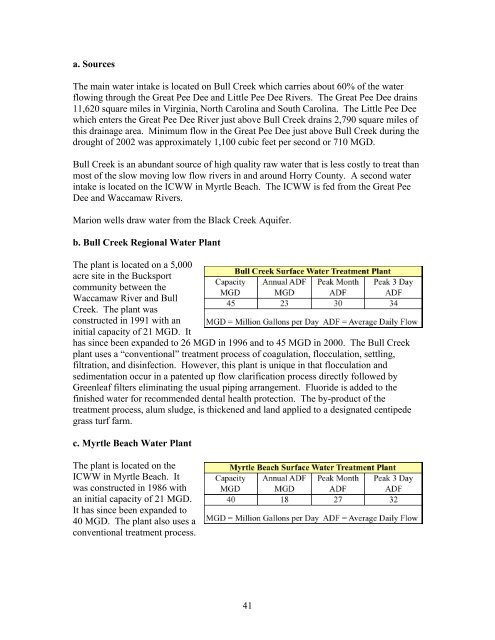2030 Plan - Grand Strand Water and Sewer Authority
2030 Plan - Grand Strand Water and Sewer Authority
2030 Plan - Grand Strand Water and Sewer Authority
Create successful ePaper yourself
Turn your PDF publications into a flip-book with our unique Google optimized e-Paper software.
a. Sources<br />
The main water intake is located on Bull Creek which carries about 60% of the water<br />
flowing through the Great Pee Dee <strong>and</strong> Little Pee Dee Rivers. The Great Pee Dee drains<br />
11,620 square miles in Virginia, North Carolina <strong>and</strong> South Carolina. The Little Pee Dee<br />
which enters the Great Pee Dee River just above Bull Creek drains 2,790 square miles of<br />
this drainage area. Minimum flow in the Great Pee Dee just above Bull Creek during the<br />
drought of 2002 was approximately 1,100 cubic feet per second or 710 MGD.<br />
Bull Creek is an abundant source of high quality raw water that is less costly to treat than<br />
most of the slow moving low flow rivers in <strong>and</strong> around Horry County. A second water<br />
intake is located on the ICWW in Myrtle Beach. The ICWW is fed from the Great Pee<br />
Dee <strong>and</strong> Waccamaw Rivers.<br />
Marion wells draw water from the Black Creek Aquifer.<br />
b. Bull Creek Regional <strong>Water</strong> <strong>Plan</strong>t<br />
The plant is located on a 5,000<br />
acre site in the Bucksport<br />
community between the<br />
Waccamaw River <strong>and</strong> Bull<br />
Creek. The plant was<br />
constructed in 1991 with an<br />
initial capacity of 21 MGD. It<br />
has since been exp<strong>and</strong>ed to 26 MGD in 1996 <strong>and</strong> to 45 MGD in 2000. The Bull Creek<br />
plant uses a “conventional” treatment process of coagulation, flocculation, settling,<br />
filtration, <strong>and</strong> disinfection. However, this plant is unique in that flocculation <strong>and</strong><br />
sedimentation occur in a patented up flow clarification process directly followed by<br />
Greenleaf filters eliminating the usual piping arrangement. Fluoride is added to the<br />
finished water for recommended dental health protection. The by-product of the<br />
treatment process, alum sludge, is thickened <strong>and</strong> l<strong>and</strong> applied to a designated centipede<br />
grass turf farm.<br />
c. Myrtle Beach <strong>Water</strong> <strong>Plan</strong>t<br />
The plant is located on the<br />
ICWW in Myrtle Beach. It<br />
was constructed in 1986 with<br />
an initial capacity of 21 MGD.<br />
It has since been exp<strong>and</strong>ed to<br />
40 MGD. The plant also uses a<br />
conventional treatment process.<br />
41






